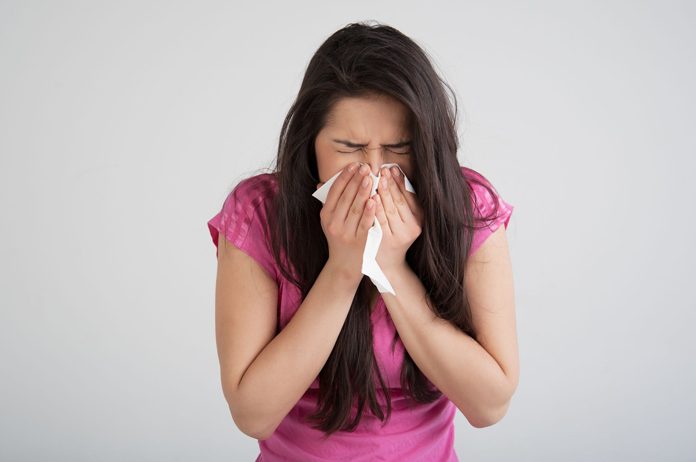None of us
When we suffer from cough and cold, we end up coughing up phlegm. This phlegm, at times, might be yellow or green in colour. Yellow or green mucous tries to tell us that the reason behind a cough might be a bacterial infection.
Viral infections can also sometimes produce coloured mucus, but they’re very uncommon. You can take the help of antibiotics in the case of bacterial infections.
However, antibiotics are not much help in the case of viral infections. When we cough up phlegm, it is the exertions of our body to get rid of the agents of infections. Phlegm is also sometimes called mucus, sputum or snot.
Many of the times, the doctors do not prescribe us cough suppressors. This is because even if coughing is uncomfortable, they help to get rid of the infection faster.
Causes
Green Mucus or yellow Mucus is the most common coloured phlegm. The main reasons behind green or yellow coloured phlegm are –
1. Bronchitis
This is a disease where inflammation of bronchial tubes occurs. The bronchial tubes are the tubes that carry the air to our lungs. When inflammation of bronchial tubes occurs, it is followed by coughing. This results in coughing up mucus.
The other symptoms are breathlessness, tightness in the chest and wheezing. The cause
The other symptoms are a sore throat, green phlegm, coughing, et cetera. It can be a lifelong condition if you suffer from chronic bronchitis, although it is very uncommon.
2. COPD (Chronic Obstructive Pulmonary Disorder Exacerbation)
Infection in the lungs causes this disease. The primary symptom is breathing problems—coughing, wheezing, productive cough and coughing up yellow Mucus. The disease is prevalent and can turn out to be very severe.
If you suffer from the following symptoms, you should immediately consult a doctor. If the condition is severe, they might even need to take you into the emergency room.
3. Bacterial Pneumonia
This is also a type of lungs infection that is often caused by a fungus or a virus. It is also a prevalent disease. The most common symptoms are cough with green mucus, headache, fatigue, and shortness of breath.
The symptoms appear within one to three weeks. You can meet your doctor, and if you follow his prescription, you will find yourself cured soon.
4. Hospital Acquired Pneumonia
This is a disease that you acquire during your stay in any hospital. It is also known as Nosocomial Pneumonia. In this case, our lungs were infected during our stay in a hospital. It can be very severe, and the symptoms show only after one or two weeks.
It is a rare disease, and the signs are green and yellow Mucus, shortness of breath, fever, chills, and appetite loss. You should immediately check in a hospital if you observe yourself showing similar symptoms.
5. Aspiration Pneumonia
Often food, saliva, vomit or other liquids enters the lungs, which causes infection. This disease is known as aspiration pneumonia. This disease can be treated within eight days and is a sporadic disease.
You will be taken into a hospital emergency room to address this. The symptoms are yellow phlegm, fatigue, shortness of breath, fever, et cetera.
6. Lung Abscess
This type of infection occurs in the lungs when pus arising from a virus gets accumulated. This results in the formation of lungs abscesses. The treatment of this disease requires six to eight weeks.
This is a sporadic disease, but an in-person appointment with the doctor will be enough to treat the disease. The symptoms are yellow mucus, pain in the ribs which increases when breathing deeply, sneezing, unintentional weight loss, et cetera.
7. Fluid Build in the Pleural Space
The pleural space is the space between the lungs and the chest. The membrane that separates the lungs and the chest is called the pleura. A lung infection occurs when fluid gets accumulated in this space.
If you’re suffering from this disease, you may be hospitalised for several days. This is a rare disease and causes you to be severely ill. The symptoms are shortness of breath, rib pain which increases when breathing, fever, coughing out green or yellow mucus, sneezing et cetera.
Treatment and Remedies
Phlegm is thus a result of different types of lung infections. Some are very serious, while others are common diseases that can be treated quickly without much problem.
If you ever notice yellow or green mucus, you know that it isn’t normal. You might wait for a few days in case it turns out to be a viral infection before you consult your doctor. It would help if you also had a note of the other symptoms to know the progress rate of your disease.
The doctor may ask you to take some tests to find out what is causing the problems. These tests may include X-rays and mucus analysis that helps in finding the cause faster. When the doctors find out the cause of the phlegm, they start the treatment for that disease.
Other than these, there are certain things that you can try at home that might help you get rid of the phlegm. Some of those are –
- You can try to keep the air inside your house moist. The moist air helps in loosening the mucus. This then results in you being able to cough out the mucus easily. For this, you can use a humidifier in your house.
- Like the moist air, providing a little bit of warmth to your throat also helps. You need to mix a half teaspoon of salt with a cup of hot water and gargle this water. This will quickly loosen the mucus which is bothering your throat as a result of an infection or allergy.
- You can also use things like essential oil at home to get rid of the yellow mucus. Other similar products like Vicks VapoRub also help us get the much-needed relief from the cough and Mucus.
- You can also use medicines like guaifenesin. It makes the mucus thin so that it can freely flow and you can cough it out quickly. It is useful in both adults and children.
- Some other simpler things that you can do are drink much fluid including water and take a lot of rest.






